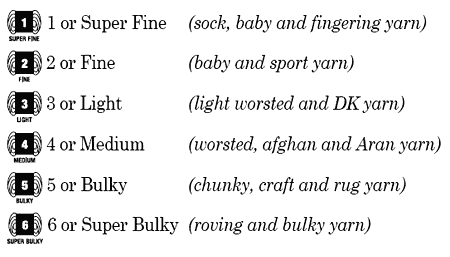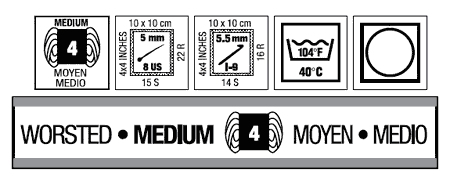- 1. What information should I look for on the yarn label?

- The information on the yarn label is helpful in selecting the type of yarn and number of skeins needed for a project. This information includes: yarn brand name, yarn fiber content (acrylic, cotton, wool, etc.), color name and number, dye lot number or statement that the yarn is “no dye lot”, plies (number of strands), yarn weight classification, ounces and/or grams, yards and/or meters, knitting or crochet gauge, home laundering and dry cleaning symbols, and home laundering instructions. You can find the meaning of the symbols by going to www.yarnstandards.com.
- 2. What is meant by “Yarn Weight Classifications?
- The “yarn weight classification” does not refer to how much a yarn “weighs” but is a standard designation for the size (diameter) of the yarn. The “yarn weight” required for a project and the amount of yarn needed to complete a project is specified in the project instructions. “Yarn weight classification” is a number and/or name assigned to yarn in the following designations:

- 3. Can I substitute one yarn weight for another yarn weight?
- No, each project is designed to be made with a specific weight of yarn. Changing the yarn weight will change the size and appearance of the finished project as well as change the amount of yarn required.
- 4. Can I substitute different yarn brands of the same yarn weight?
- Yes, but be sure to test the “gauge” to make sure that an adjustment is not necessary as you substitute one yarn for another. See question # 8 to learn more about “gauge.”
- 5. Why do some yarns have a dye lot number and others are no dye lot?
- Some yarns are dyed in large batches with each batch assigned a “dye lot number”. Using a color from the same dye batch assures a color match from skein to skein. Other yarns are spun from fiber that is already colored and are labeled as “no dye lot” yarns.
- 6. What are the differences in steel, aluminum, and plastic crochet hooks? When do I use one kind versus another?
- Crochet hooks are made in a variety of materials such a wood, plastic, aluminum, bamboo, and steel. They come in many sizes designed to be used with different yarn weights. The choice of material is one of personal preference. Crochet hook sizes are indicated by letters, numbers, or millimeters (mm). The project instructions will specify the size crochet hook size required for the pattern.
- 7. What are double point and circular knitting needles used for? How are they similar and how are they different?
- Double point and circular needles are different from straight knitting needles and are used for seamless knitting or “knitting-in-the-round.” Double point knitting needles come in sets of four or five and are used to make smaller round pieces such as cuffs, socks and mittens. Circular knitting needles come in various lengths and sizes, and are the tools of choice for larger round sections such as sleeves, collars, and the body of a sweater. Circular knitting needles may also be used for knitting back and forth and are ideal for working in close quarters, such as in the car. Like with crochet hooks, knitting needles come in a variety of materials and the choice of which one to use is a matter of personal preference. The size on knitting needle required for a project is specified in the project instructions.
- 8. What is “gauge” and how is it determined?
- Gauge is the number of stitches and rows in every inch of knitting and the number of stitches and rows (or rounds) in every inch of crochet. The required gauge is specified in knitting and crochet patterns, and determines the finished size of the project. Since everyone knits and crochets differently, it is very important that you make a gauge swatch and match it with the gauge specified in the project pattern. You may find that if you knit or crochet loosely, you may have to use a needle or hook smaller than the pattern specifies. Likewise, if you knit or crochet tightly, you may need to use a needle or hook larger than the pattern specifies. It doesn’t matter what size needle or hook you use as long as your gauge swatch has the same number of stitches and rows per inch as specified in the pattern.
- 9. What is the best way to launder projects made from yarn?
- The first step is to check the laundering instructions on the yarn label. This will tell you whether to machine wash and dry or hand launder and dry flat. Even if the yarn label indicates that you may machine wash and dry, remember that you are caring for a hand made item. It is recommended that delicate items be washed in a mesh laundry bag or pillow case and that you wash your hand made items separately from your other laundry.
- 10. Where can I get help when I have yarn questions?
- In store yarn department you will find numerous yarn books that will be helpful. You can also find information at information online by searching for help in your favorite search engine or video site.


